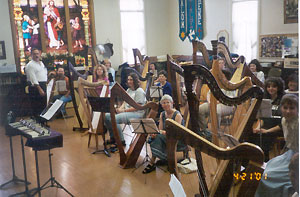 | 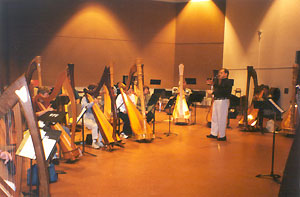 |
Chicago Chapter of AHS, Liz Cifani, Organizer
|
Winston-Salem, NC. AHS Chapter.
Organized by Julie Hammarback.
Held at Wake Forest University. |
For a retrospective of photographs of numerous workshop locations through the years, accompanied by my own solo harp arrangements, please visit a video clip titled “The Workshop Trail”.
1. Lever Harp Tuning Technique and Comparison
A description of the entire tuning process from calibration, using an external microphone, location of tuner / microphone / tuning key / harp, the order of strings to be tuned in both C and E flat Major. A chord comparison to find convenient accidentals in the key of C Major with E flat tuning.
2. The Treble Harpist
Designed for entry level students of music on the harp. Note reading, rhythm exercises and arrangements at five levels of increasing complexity. All work is done on a single staff in the treble clef. The complete range of notes includes the F below middle C (three ledger lines below the staff) to the soprano high C (two ledger lines above the staff.) Repertoire is drawn from folk tunes, hymn tunes, Hebrew melodies, vintage American standards and songs of Stephen Foster.
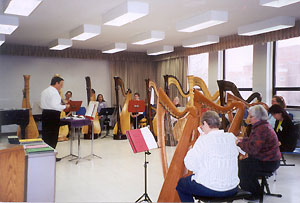 |
Ball State University, Muncie, IN.
Elizabeth Richter, Harp Instructor. |
3. Chord Talk
The major scale identified by both pitch and Roman numeral, diatonic intervals measured from I and diatonic triads that occur automatically within the key. An elementary and shortened version of "3's a Chord."
4. 3's a Chord
A study of the major and chromatic scale in C major, intervals, chords inversions, the Tonic, Sub-dominant and Dominant chords and the I - IV - V - I chord progression. The ultimate study of C Major!
5. Hymn Leadsheet Workshop
A study of 5 categories of musical composition which are immediately applied in the performance of hymn tunes from leadsheets taken from the 100 titles in "Hymns & Harmony." This is the preparation for any sort of music from a leadsheet or fakebook format, regardless of textual content.
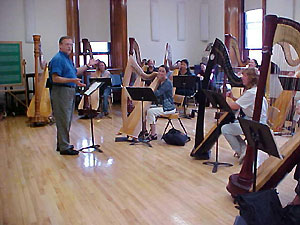 | 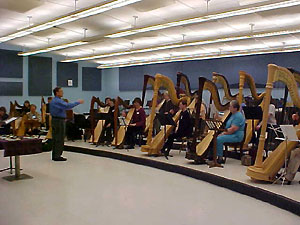 |
Eastman School of Music, "Summer Session"
with Kathleen Bride, Professor of Harp | Milwaukee, WI. Students and Friends of
Ann Lobotzke |
6. Improvisation / Modulation Workshop
Patterns of improvisation on three chord progressions which include: I - IV - V - I, I - VI - II - V and I - IV - VII - III - VI - II - V - I. Also includes information on modulation among six keys playable on lever harp and pedal harp simultaneously.
7. The Instant Harp Ensemble
An extensive study of how to accompany a melody line from a lead sheet. Examples of accompaniment patterns with the three chord progressions discussed in the workshop (6) listed above. Also includes an extensive discussion of the circle of 5th's. Three familiar melodies accompanied with strumming chords, rhythmic opposition to melodic values and ascending/descending chord inversions. Completely presented in lead sheet notation.
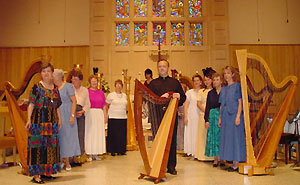 |
Corpus Christi, TX, Private Studio of
Patricia Wentworth Furley |
8. Blazing Pedals / Clever Levers Workshop
The ultimate in diatonic harmony. A study of seventh chords continues into a discussion of chord tones of the 9th, 11th and 13th. "The Common Glissando" is illustrated for pedal and lever harp simultaneously. Includes performance of a lead sheet melody in three keys with modulation interludes included.
9. Leverobics
This contains harmonic patterns that are available on lever harp when levers are moved quickly for chords outside the key signature. Items for study include basic lever identification and movement with agility, the chromatic scale, the whole tone scale with a dominant function, secondary dominants and modulation progressions.
10. "1-2-3-Play!"
A study of melody development with increasing range using numbers (1, 2, 3, 4, 5....) for the steps of the scale. All samples will be notated on a traditional 5 line staff. Each note will contain its degree of the scale within its shape. Quarter and eighth notes will have black note heads with white numbers in their centers. Half and whole notes will have white noteheads with black numbers in their centers. The melodies will be introduced in order of increasing range:
1 - 3:
Hot Cross Buns; Au Clair de la Lune (first half)
1 - 5:
When the Saints Go Marchin' In; Drink To Me Only; Jingle Bells ... and many more
1 - 6:
Twinkle, Twinkle Little Star; Michael, Row the Boat Ashore; Kumbayah .... and many more
(7) 1 - 5 (including the lower leading tone)
Skip To My Lou; Coventry Carol (minor key); Patapan ... and many more
(7) 1 - 6 (again with the lower leading tone)
America; He's Got the Whole World In His Hands; Now Thank We All Our God (includes an accidental)
(5) 1 - 5 (includes the range of an octave from the lower dominant)
I Know Where I'm Goin'; Home on the Range; Good King Wenceslas ... and DOZENS more
(5) 1 - 6
All Through the Night; Long, Long Ago; Il est né ... and DOZENS more
1 - [1] (an entire octave from "do" to "do")
Row, Row, Row Your Boat; On Top of Old Smokey; The First Nowell and DOZENS more...
11. Lunchtime Music Demo
This is a presentation of samples from various publications that are offered for sale at a 40% discount to all workshop participants.
All workshops are for participation by Lever and Pedal Harp simultaneously, without exception!
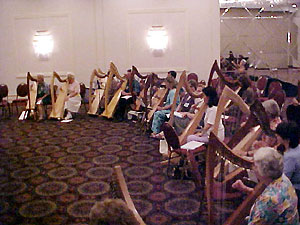 | 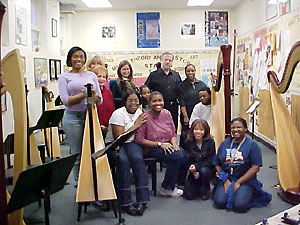 |
Somerset Folk Harp Festival. Somerset, NJ.
Gerry Serviente, Festival Presenter. | Newark, NJ. Harp Class of Robin Gordon-Cartier |
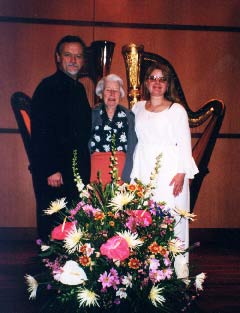
|
Karen Thielen, Harp Instructor at Santa Clara University sponsored legendary harpist and teacher Lucile Lawrence in a weekend of private lessons and a Master Class.
I participated with the workshop presentation and shared a solo recital with Karen.
|
|

